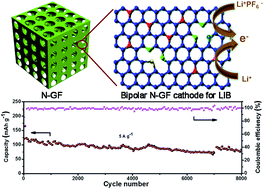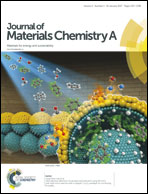Bipolar nitrogen-doped graphene frameworks as high-performance cathodes for lithium ion batteries†
Abstract
Hierarchically porous nitrogen-doped graphene frameworks (N-GFs) are fabricated through the ice-templating of GO with polyethylenimine and the thermal treatment of the resultant hybrids. As cathode materials in lithium ion batteries (LIBs), the obtained N-GFs exhibit an outstanding specific capacity of 379 mA h g−1 at 0.5 A g−1 for 2500 cycles. Even at an ultrahigh current density of 5 A g−1, the N-GFs maintain a capacity of 94 mA h g−1, superior to that of most reported LIB cathode materials. The experimental results and quantum mechanics calculations suggest that pyridinic-like N and pyridinic N-oxide in graphene are responsible for the excellent cathodic performance of the bipolar N-GFs by providing fast surface faradaic reactions with both p- and n-doped states.



 Please wait while we load your content...
Please wait while we load your content...